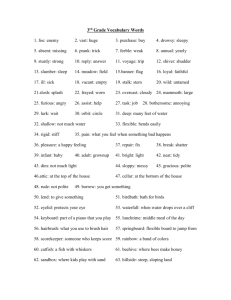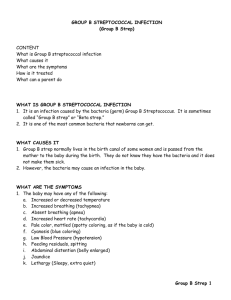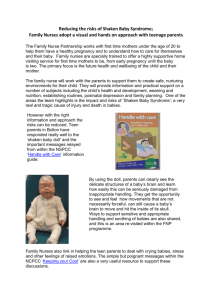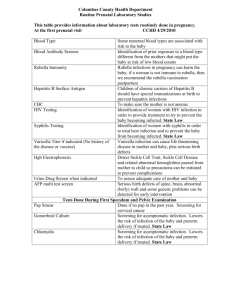Infection of the Newborn - Follow “Childspecialist.wordpress.com”
advertisement
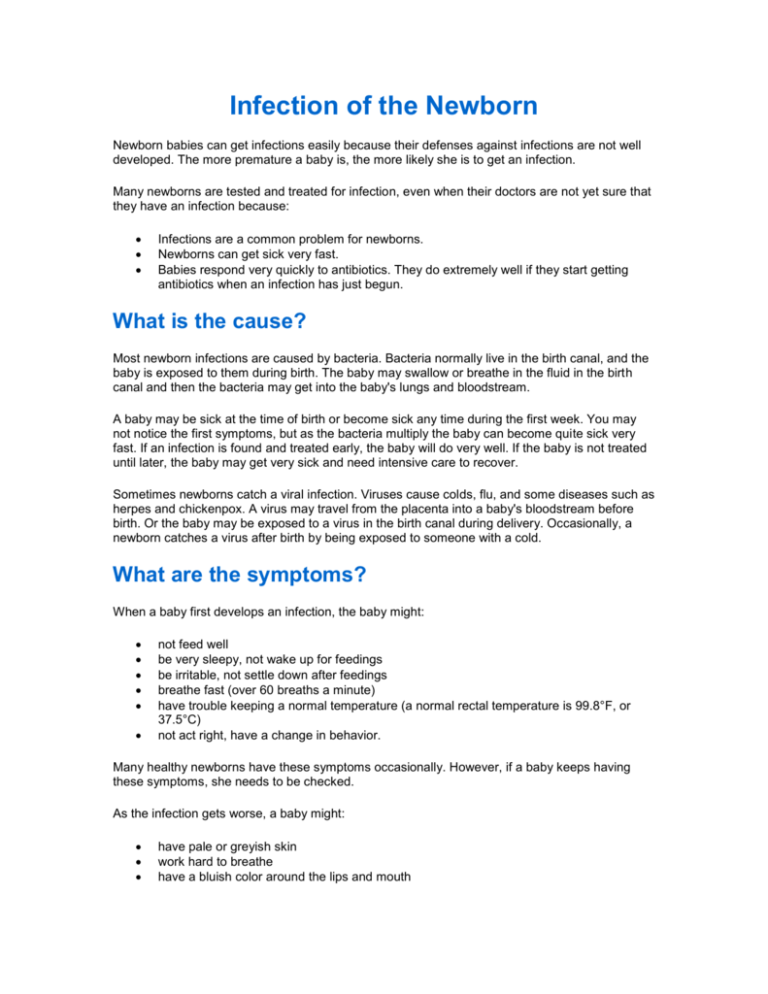
Infection of the Newborn Newborn babies can get infections easily because their defenses against infections are not well developed. The more premature a baby is, the more likely she is to get an infection. Many newborns are tested and treated for infection, even when their doctors are not yet sure that they have an infection because: Infections are a common problem for newborns. Newborns can get sick very fast. Babies respond very quickly to antibiotics. They do extremely well if they start getting antibiotics when an infection has just begun. What is the cause? Most newborn infections are caused by bacteria. Bacteria normally live in the birth canal, and the baby is exposed to them during birth. The baby may swallow or breathe in the fluid in the birth canal and then the bacteria may get into the baby's lungs and bloodstream. A baby may be sick at the time of birth or become sick any time during the first week. You may not notice the first symptoms, but as the bacteria multiply the baby can become quite sick very fast. If an infection is found and treated early, the baby will do very well. If the baby is not treated until later, the baby may get very sick and need intensive care to recover. Sometimes newborns catch a viral infection. Viruses cause colds, flu, and some diseases such as herpes and chickenpox. A virus may travel from the placenta into a baby's bloodstream before birth. Or the baby may be exposed to a virus in the birth canal during delivery. Occasionally, a newborn catches a virus after birth by being exposed to someone with a cold. What are the symptoms? When a baby first develops an infection, the baby might: not feed well be very sleepy, not wake up for feedings be irritable, not settle down after feedings breathe fast (over 60 breaths a minute) have trouble keeping a normal temperature (a normal rectal temperature is 99.8°F, or 37.5°C) not act right, have a change in behavior. Many healthy newborns have these symptoms occasionally. However, if a baby keeps having these symptoms, she needs to be checked. As the infection gets worse, a baby might: have pale or greyish skin work hard to breathe have a bluish color around the lips and mouth have a low body temperature despite normal wrapping with clothes or blankets (a rectal temperature under 98°F, or under 36°C) have a high body temperature (a rectal temperature over 100°F, or over 38°C). Some newborns may have an infection in one specific part of their body. In these cases you might see: redness or swelling of skin, often around the umbilical cord or circumcision redness, swelling, or yellowish discharge from the eyes blisters on the skin. How is it diagnosed? The early signs of infection are subtle and hard to diagnose. For example, your baby's fast breathing could be caused by an infection or by fluid in the lungs. If treatment is not given until it is certain your baby has an infection, he may become quite sick and need special care. So, if your baby has 1 or 2 signs of infection, he is often tested for infection and antibiotics are given until the results of the tests come back. The results are usually back in 48 to 72 hours. Lab Tests Certain lab tests will show if a baby has an infection and where it is located. Your health care provider may choose one or more of the following tests: Blood test: A sample of the baby's blood is taken for a blood count (CBC) and blood culture. The CBC counts the different types of cells in the blood. The blood culture is a test to see if bacteria can be grown from the blood. If a baby does have an infection, bacteria usually grow in a culture within 2 to 3 days. If the test is negative (no bacteria grew) and the baby's symptoms go away quickly, or if some other cause is found for the symptoms, the baby probably does not have an infection and the antibiotics will probably be stopped. Urine Test: A sample of the baby's urine is tested for signs of infection. Secretion Test: If there is an obvious site of infection, a sample of secretions may be cultured (for example, pus from around the umbilical cord or eye). Chest X-Ray: If a baby is having trouble breathing, a chest x-ray may be taken to look for signs of pneumonia. Spinal Tap: Meningitis is a serious infection of the fluid surrounding the brain. Any baby who is very sick from infection or has bacteria in her blood could get meningitis. Meningitis is diagnosed by doing a test called a spinal tap (or lumbar puncture, LP) to get a sample of spinal fluid. Spinal taps are safe for babies. The baby is curled on her side for the test. To make sure that she is breathing OK during the test, the baby is attached to a monitor and a nurse holds and watches the baby during the spinal tap. A hollow needle is put into the space in the baby's back below the spinal cord and a small amount of spinal fluid is taken. The fluid is then tested for infection. Most babies do not like to be held in this position and will cry during the test, but a spinal tap is no more painful than drawing blood. It takes 5 to 10 minutes to do a spinal tap. If a baby is having problems with breathing or for other reasons, the doctor may start antibiotics and wait to do the spinal tap until the baby is better able to handle the test. Parents are asked for their written or verbal consent before the spinal tap is done. Some parents worry that putting a needle so close to the spinal cord will cause the baby to become paralyzed. However, there is almost no risk of paralysis because the needle is put into the space below the end of the spinal cord. How is it treated? The Special Care Nursery (SCN) If a baby has signs of infection, she is taken to the special care nursery (SCN) for evaluation and treatment. The baby is placed on a warming bed. She is attached to a monitor, which continuously measures heart rate and breathing. If the baby is having trouble breathing, she is attached to a monitor that records the amount of oxygen in her skin. This monitor is called a pulse oximeter. Medicine Suspected bacterial infections are treated with antibiotics. After the lab tests are begun, an intravenous line (IV) is put into one of the baby's veins. The IV is used to give antibiotics to newborns to make sure that the right amount of antibiotic reaches the baby's bloodstream. Antibiotics are not well absorbed into the blood from a baby's stomach. If the lab tests are positive for a bacterial infection or the baby's symptoms strongly suggest infection, the baby will continue to receive IV antibiotics for 7 to 14 days. If your baby has a viral infection, it cannot be treated with antibiotics. Most babies will be able to fight the infection without medicine. However, there are now a few antiviral medicines that can be used for specific viral infections, such as herpes and chickenpox. Supportive care Antibiotics help a baby fight infection. Other treatments help the baby's symptoms. If the baby is breathing too fast to eat, he is given fluids through the IV so he won't get dehydrated. If he is too sleepy to eat, he may be given IV fluids or he may be fed by dripping milk through a tube that passes through his mouth and into the stomach. If the baby needs extra oxygen, he is placed in a plastic hood into which extra oxygen is blown. Some babies are relatively well and the only treatment they need is antibiotics. These babies are able to breast-feed or bottle-feed. Will there be complications? Nearly all babies who have infection when they are newborns recover completely and do not suffer any long-term problems. Babies who have meningitis are at risk for hearing loss and will need to have their hearing checked several times during their first year. They can also develop learning or other developmental problems later on and will need to be followed by their health care provider for these problems.

